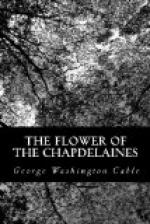It has had many owners. As with the woman in the Sadducee’s riddle, she of many husbands, seven political powers have had this mermaid as bride. Spain, the English, the Dutch, the Spaniards again, the French, the Knights of Malta, the French again, who sold her to the Guiana Company, who in 1734 passed her over to the Danes, from whom the English captured her in 1807 but restored her again at the close of Napoleon’s wars. Thus, at last, Denmark prevailed as the ruling power; but English remained the speech of the people. The island is about twenty-three miles long by six wide. Its two towns are Christiansted on the north and Fredericksted on the south. Christiansted is the capital.
In 1848 I lived in Fredericksted, on Kongensgade, or King Street, with my aunts, Marion, Anna, and Marcia, and my grandmother—whom the servants called Mi’ss Paula—and was just old enough to begin taking care of my dignity. Whether I was Danish, British, or American I hardly knew. When grandmamma, whose husband had been of a family that had furnished a signer of our Declaration, told me stories of Bunker Hill and Yorktown I glowed with American patriotism. But when she turned to English stories, heroic or momentous, she would remind me that my father and mother were born on this island under British sway, and—“Once a Briton always a Briton.” And yet again, my playmates would say:
“When you were born the island was Danish; you are a subject of King Christian VIII.”
Kongensgade, though narrow, was one of the main streets that ran the town’s full length from northeast to southwest, and our home was a long, low cottage on the street’s southern side, between it and the sea. Its grounds sloped upward from the street, widened out extensively at the rear, and then suddenly fell away in bluffs to the beach. It had been built for “Mi’ss Paula” as a bridal gift from her husband. But now, in her widowhood, his wealth was gone, and only refinement and inspiring traditions remained.
The sale or hire of her slaves might have kept her in comfort; but a clergyman, lately from England, convinced her that no Christian should hold a slave, and setting them free she accepted a life of self-help and of no little privation. She was his only convert. His zeal cooled early. Her ex-slaves, finding no public freedom in custom or law, merely hired their labor unwisely and yearly grew more worthless.
[The reader lifted his eyes across to Aline:
“I had a notion to name that much ‘The Time,’ and this next part ’The Scene.’ What do you think?”
“Yes, I think so. ’Twould make the manner of it less antique.”
“Ah!” cried Mlle. Corinne, “’tis not a movie! Tha’z the charm, that antie-quitie!”
“Yes,” the niece assented again, “but even with that insertion ’tis yet as old-fashioned as ‘Paul and Virginia.’”
“Or ‘Rasselas,’” Chester suggested, and resumed his task.]




